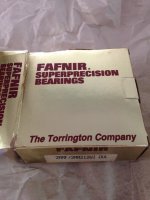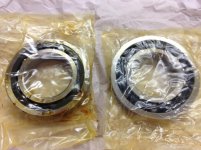I decided to pay Monarch to regrind my D1-3 nose as suggested by Cal. Monarch charges $1200 to regrind the nose (and the Jarno inside), and yes, it is a lot of money, but the undersized D1-3 taper on my spindle was going to render my machine marginal at best, and since I had to get new bearings, I decided to work a bit of extra overtime and pay to get the spindle done right...
Along with the overtime for the spindle, the new bearings took a couple more days overtime to cover their cost. I got the Fafnir bearings from Robert at General Bearings in Los Angeles for $1200. These are the bearings Daryl used in his rebuild, and the only alternative is $2800 to Monarch for their Barden bearings. Daryl's story is that General Bearing bought 100 bearing pairs in the 70's from Fafnir, custom made, as the front flange bearing is not a stock bearing. I don't know if that is true, but the salesman said they had been on the shelf for many, many years, and they still had quite a few left.
The Fafnir designation is as follows:
2 - 15 degree contact angle
MM - precision between ABEC7 and ABEC9/ISO P4-P2 (original New Departure were ABEC5)
F - flange
212 - size
WI - low shoulder on outer ring (i.e. normal angular type)
DUL - duplex mounting light preload
The original New Departure bearing pair is medium preload, but beggars can't be choosers. Daryl tells me he has has had no issues with his bearings and he got around 50 millionths runout with them
I wish I had taken a picture of my spindle taper before I sent it to compare to the regrind, but I forgot. Steve at Monarch tells me the spindle cleaned up very well. I set it in one of my backplates and there is the slightest bit of light between the spindle and backplate, so that is encouraging. I don't have the cams in it to tighten down, but I would say the gap is between 0.001 and 0.002, right where it should be.
To install the bearings I am thinking about getting dry ice to put inside the spindle to contract it to help get the bearings on easily. Any thoughts on that idea?
Along with the overtime for the spindle, the new bearings took a couple more days overtime to cover their cost. I got the Fafnir bearings from Robert at General Bearings in Los Angeles for $1200. These are the bearings Daryl used in his rebuild, and the only alternative is $2800 to Monarch for their Barden bearings. Daryl's story is that General Bearing bought 100 bearing pairs in the 70's from Fafnir, custom made, as the front flange bearing is not a stock bearing. I don't know if that is true, but the salesman said they had been on the shelf for many, many years, and they still had quite a few left.
The Fafnir designation is as follows:
2 - 15 degree contact angle
MM - precision between ABEC7 and ABEC9/ISO P4-P2 (original New Departure were ABEC5)
F - flange
212 - size
WI - low shoulder on outer ring (i.e. normal angular type)
DUL - duplex mounting light preload
The original New Departure bearing pair is medium preload, but beggars can't be choosers. Daryl tells me he has has had no issues with his bearings and he got around 50 millionths runout with them
I wish I had taken a picture of my spindle taper before I sent it to compare to the regrind, but I forgot. Steve at Monarch tells me the spindle cleaned up very well. I set it in one of my backplates and there is the slightest bit of light between the spindle and backplate, so that is encouraging. I don't have the cams in it to tighten down, but I would say the gap is between 0.001 and 0.002, right where it should be.
To install the bearings I am thinking about getting dry ice to put inside the spindle to contract it to help get the bearings on easily. Any thoughts on that idea?
Attachments
Last edited:








